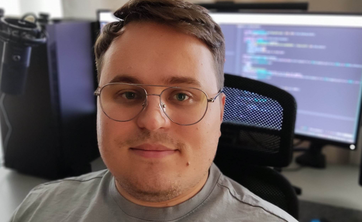Three students from our Faculty took part in the finals of HackING – the hackathon of ING Bank Śląski. The team composed of: Ireneusz Placek, Bartosz Procki and Bartłomiej Koba took second place and won PLN 6,000. Congratulations!
 The hackathon started on 18 May in an online format and lasted 48 hours. It gathered nearly 100 students of technical faculties from all over Poland divided into 30 teams. Supported by experienced mentors and experts, the teams worked on developing the most accurate document recognition and classification model based on prepared data in the form of texts and scans. The prize pool was PLN 20,000 in cash.
The hackathon started on 18 May in an online format and lasted 48 hours. It gathered nearly 100 students of technical faculties from all over Poland divided into 30 teams. Supported by experienced mentors and experts, the teams worked on developing the most accurate document recognition and classification model based on prepared data in the form of texts and scans. The prize pool was PLN 20,000 in cash.
The aim of the hackathon was to build a community focused around AI solutions and to make young talented people familiar with issues related to the use of data sources, technologies and tools in financial institutions. In the first edition, the participants could learn about modern techniques and find out what it is like to work in an IT department in a bank.
 The team called Drapaki was co-created by first degree students of the second year of System Engineering. Ireneusz Placek, Bartosz Procki and Bartłomiej Koba were classified second and won PLN 6,000 in cash.
The team called Drapaki was co-created by first degree students of the second year of System Engineering. Ireneusz Placek, Bartosz Procki and Bartłomiej Koba were classified second and won PLN 6,000 in cash.
 The task was to categorize approximately 3,500 documents in Polish and English into 21 different categories using any Python-based classification algorithm, explained one of the team members. His team was recognized for the accuracy of the classification algorithm, but they also received additional points for clean and readable code.
The task was to categorize approximately 3,500 documents in Polish and English into 21 different categories using any Python-based classification algorithm, explained one of the team members. His team was recognized for the accuracy of the classification algorithm, but they also received additional points for clean and readable code.

– Our project used initial language categorization (Google's OCR Algorithm + language models for language recognition) to divide documents into Polish and English language, because in the case of Polish documents they were highly schematic and the algorithm categorized them on the basis of eigenvectors of the most common words for each class (e.g. in the case of PIT, the word PIT appeared very often). In the case of documents in English, our algorithm was based on the CNN (photos) and RNN (previously loaded text) algorithm models trained on about 9,000 documents – explained Ireneusz Placek.
You can view the code developed by our students in the final of the ING hackathon here.


